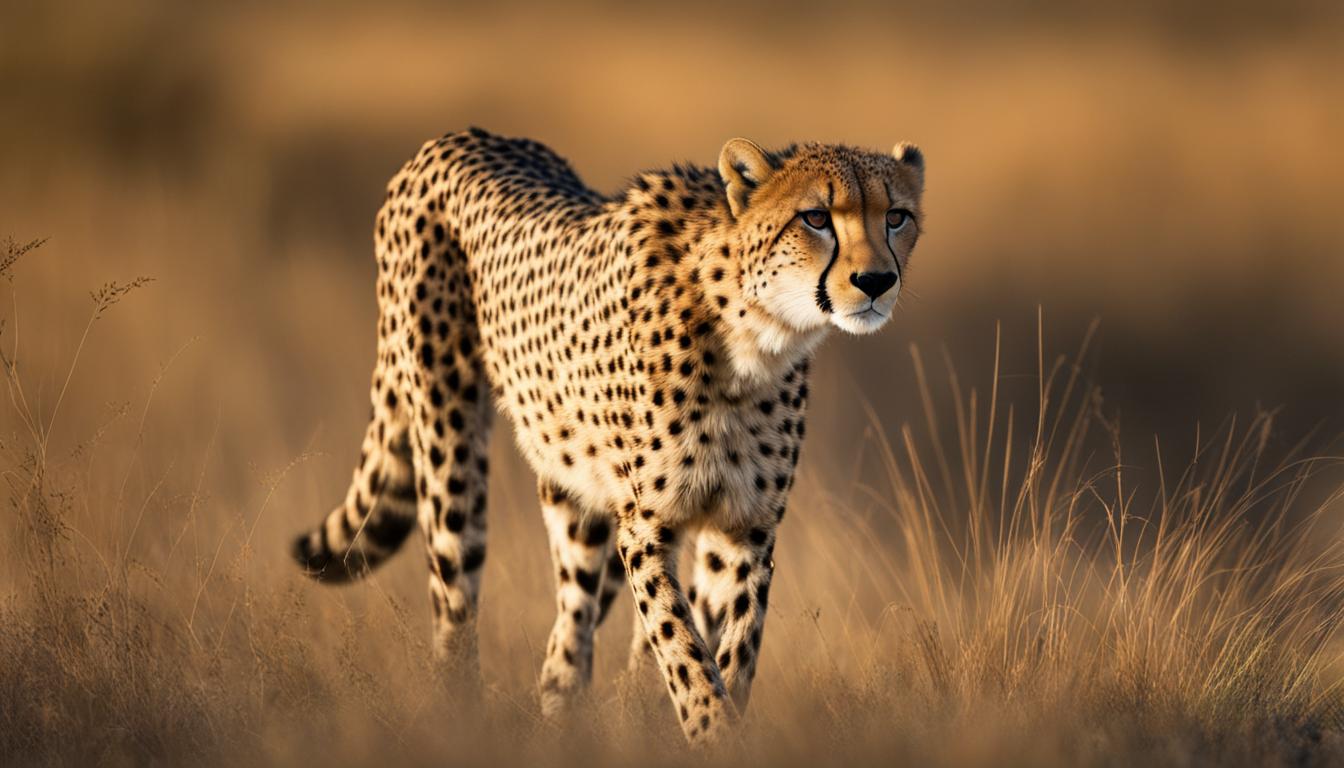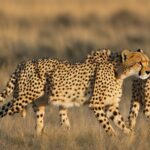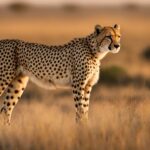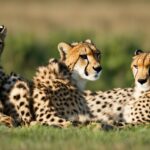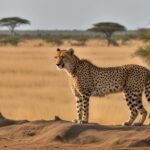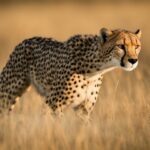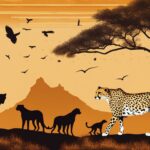When it comes to the survival of cheetahs in the wild, it’s crucial to understand the role of predators in their ecosystem. Cheetahs, known for their incredible speed and agility, are not entirely safe from other predators. Lions, leopards, and hyenas are among the natural predators that pose a threat to cheetahs, especially their vulnerable cubs.
Lions, in particular, have been known to steal kills from cheetahs and may also target their cubs when given the opportunity. However, adult cheetahs possess the remarkable ability to outrun most predators in short bursts, relying on their speed and agility to flee rather than fight when confronted by larger animals. Despite this advantage, cheetahs must remain vigilant in order to survive in their natural habitat.
Understanding the dynamics between cheetahs and their predators is essential for their conservation and preservation. By studying these interactions and implementing effective conservation strategies, we can ensure the long-term survival of these magnificent creatures.
Cheetah Hunting Techniques
Cheetahs are highly specialized hunters and have developed unique hunting techniques to increase their chances of success. They are diurnal hunters, meaning they hunt during the day, unlike most other big cats. Cheetahs are known for their incredible speed, which allows them to sprint at high speeds of up to 60-70 miles per hour in short bursts. They use their exceptional eyesight to scan the savannah for potential prey, such as small antelope like Thomson’s gazelle.
Once they spot their target, cheetahs use their stealth and camouflage to get as close as possible before launching a lightning-fast chase. They rely on their speed and agility to outmaneuver their prey and deliver a quick, lethal bite to the throat or nape of the neck to bring it down. Their slender and lightweight bodies are designed for speed, with long legs and a flexible spine that allows for efficient strides. Cheetahs also have non-retractable claws that provide better traction while running, acting like cleats on a football player’s shoes.
“Cheetahs use their speed and agility to outmaneuver their prey and deliver a quick, lethal bite to the throat or nape of the neck to bring it down.”
During a chase, cheetahs demonstrate remarkable maneuverability, quickly changing direction or leaping over obstacles to maintain their pursuit. They can cover significant distances in a short amount of time, using bursts of speed that can only be sustained for about half a minute. If the initial chase is unsuccessful, cheetahs will often abandon the hunt, conserving energy for the next opportunity. Their hunting success rate can vary, but it is estimated to be around 50%, making them one of the most successful hunters in the animal kingdom.
Cheetah Hunting Techniques
| Type of Hunting Technique | Description |
|---|---|
| Stalking | Cheetahs use their exceptional eyesight and stealth to get as close as possible to their prey before initiating a chase. |
| Pursuit | Once in range, cheetahs launch a lightning-fast chase, relying on their speed and agility to outmaneuver their prey and deliver a quick, lethal bite to the throat or nape of the neck to bring it down. |
| Maneuverability | Cheetahs demonstrate remarkable agility during a chase, quickly changing direction or leaping over obstacles to maintain their pursuit. |
| Bursts of Speed | Cheetahs can sustain high speeds of up to 60-70 miles per hour for short bursts, covering significant distances in a matter of seconds. |
Overall, cheetahs’ hunting techniques, combined with their exceptional speed and agility, make them highly efficient predators. Their ability to adapt and specialize in diurnal hunting sets them apart from other big cats, enabling them to thrive in their unique ecological niche.
Cheetah’s place in the food chain and ecosystem
Cheetahs play a crucial role in their ecosystem as top predators. Their presence helps maintain a balanced food chain by controlling the population of their prey species, such as antelopes. As carnivores, cheetahs are part of a complex web of interactions within their ecosystem. They rely on other species for their survival, such as the availability of prey species and the absence of larger predators that may compete with them for resources. The decline in cheetah populations can have cascading effects on the entire ecosystem, leading to imbalances in prey populations and other ecological processes.
Being apex predators, cheetahs have a significant impact on regulating populations of herbivores within their habitat. By hunting and preying on antelopes, such as Thomson’s gazelle, cheetahs help control their numbers, preventing overgrazing of vegetation and promoting a healthy balance in the ecosystem. This, in turn, has positive effects on the habitat and other fauna and flora that depend on it.

The table below illustrates the cheetah’s place in the food chain and its impact on the ecosystem:
| Role | Effect |
|---|---|
| Top Predator | Controls population of prey species, prevents overgrazing, and maintains a balanced ecosystem |
| Regulator of Herbivore Numbers | Prevents overpopulation of antelopes, reducing competition for resources and promoting vegetation regrowth |
| Biodiversity | Contributes to the diversity and stability of the ecosystem by maintaining a healthy predator-prey balance |
| Impact on Trophic Levels | Affects the abundance and distribution of organisms at various trophic levels within the food web |
“Cheetahs are instrumental in the functioning of their ecosystems, both as predators and regulators of herbivore populations. Their presence ensures the sustainability and health of the ecosystem, benefiting other native species and maintaining the delicate balance of nature.”
Cheetahs have coexisted with other organisms in their habitats for thousands of years. The intricate web of relationships they form with prey species, competing predators, and surrounding biodiversity highlights their integral role in the functioning of the natural world. Protecting cheetah populations is not only vital for their survival but also for the preservation of the overall biodiversity and ecological stability of their habitats.
Threats to Cheetahs and Conservation Efforts
Cheetahs face a range of threats in the wild, which have contributed to their declining populations and their vulnerable status according to the IUCN. These threats include habitat loss, poaching, and conflicts with humans. The natural predators of cheetahs, such as lions and hyenas, also pose a direct threat to their survival, particularly for cheetah cubs. Additionally, cheetahs often fall victim to farmers and ranchers who kill them to protect their livestock.
To ensure the long-term survival of cheetahs, conservation efforts are paramount. Many organizations are working tirelessly to protect these iconic animals and their habitats. One key focus of conservation efforts is raising awareness about the importance of cheetah conservation and the need to reduce human-wildlife conflicts. By promoting coexistence between cheetahs and local communities, it is possible to minimize negative encounters and create a more harmonious relationship.
“Cheetahs face numerous threats in the wild, including habitat loss, poaching, and conflicts with humans.”
Protected areas play a critical role in cheetah conservation. They provide safe havens for cheetahs to thrive and breed without fear of persecution. These protected areas also help to maintain biodiversity and support the delicate balance of the ecosystem. Sustainable land management practices are equally important, as they ensure the preservation of suitable habitats for cheetahs and their prey.
Table: Conservation Efforts for Cheetahs
| Conservation Efforts | Description |
|---|---|
| 1. Raising Awareness | Public outreach campaigns to educate people about cheetahs and the importance of their conservation. |
| 2. Human-Wildlife Conflict Mitigation | Implementing strategies to reduce conflicts between cheetahs and local communities, such as improved livestock protection measures. |
| 3. Protected Areas | Establishing and managing protected areas specifically for cheetahs, ensuring their safety and access to suitable habitats. |
| 4. Anti-Poaching Measures | Strengthening law enforcement efforts to combat poaching and the illegal wildlife trade. |
Conservation efforts for cheetahs require collaboration between governments, local communities, and international organizations. With continued support and commitment, it is possible to protect these magnificent animals for future generations and ensure their rightful place in the world’s ecosystems.

Cheetah Reproduction and Family Dynamics
Cheetah reproduction involves brief encounters between males and females. After a gestation period of around 90-95 days, a female cheetah gives birth to a litter of 3-6 cubs. These cubs are born blind and helpless, relying entirely on their mother for care and protection. The mother cheetah will move the cubs to different hiding places to keep them safe from predators.
During the first 1.5-2 years of their lives, the cheetah cubs stay with their mother. This period is crucial for their development, as they learn essential hunting skills and develop independent survival strategies. While female cheetahs are generally solitary animals, except when they have cubs, male cheetahs often form coalitions. These coalitions consist of brothers or unrelated males that join forces to increase their chances of survival and territorial control.
The reproductive dynamics of cheetahs are fascinating and help ensure the continuation of the species. The brief encounters between males and females, followed by the prolonged care of the cubs by the mother, contribute to the survival and growth of the cheetah population in the wild.
The Future of Cheetahs and the Importance of Conservation
Cheetahs, one of the most iconic and majestic animals on our planet, are facing a challenging future. Currently listed as a vulnerable species, their populations continue to decline at an alarming rate. The importance of conservation efforts for cheetahs cannot be overstated. It is crucial that we take immediate action to protect these magnificent creatures and secure their existence for future generations.
Conservation plays a vital role in safeguarding cheetah populations. By protecting their natural habitats, we create safe havens for cheetahs to roam freely and thrive. This involves preserving the vast savannahs and grasslands that these graceful big cats call home. Additionally, efforts are being made to minimize human-wildlife conflicts, promoting coexistence between local communities and cheetahs. By working together, we can find sustainable solutions that benefit both humans and these incredible animals.
Joining hands with dedicated conservation organizations is crucial in supporting cheetah conservation efforts. These organizations tirelessly work to raise awareness about the plight of cheetahs and advocate for their protection. By supporting these initiatives, you can contribute to the ongoing conservation work that aims to save cheetahs from extinction. Every small effort counts, from spreading awareness to donating to these organizations, as they strive to ensure a future for these vulnerable creatures.
The future of cheetahs lies in our hands. It is up to us to make a difference and take a stand for their survival. By prioritizing cheetah conservation, we can not only protect these incredible animals but also preserve the delicate balance of our ecosystems. Together, we can create a future where cheetahs continue to roam the savannahs, embodying the wild beauty and resilience that makes them so unique.
Do Leopards Pose a Threat to Cheetahs in the Wild?
Leopard behavior in the wild is a potential threat to cheetahs. Leopards are known to prey on cheetahs and their cubs, posing a significant danger to the species. This predatory behavior can impact cheetah populations in their natural habitat, making it a concerning issue for conservation efforts.
How do natural predators of cheetahs impact conservation efforts for the species?
The presence of natural predators such as lions and hyenas can have a significant impact on successful cheetah conservation cases. These predators can outcompete cheetahs for food and pose a threat to their survival. Efforts to protect cheetahs must take into account the role of these predators in their ecosystem.
FAQ
Are cheetahs hunted by other predators in the wild?
Yes, cheetahs are primarily hunted by other predators such as lions, leopards, and hyenas.
Do cheetahs have any natural predators?
Yes, larger and more powerful predators like lions, leopards, and hyenas can pose a threat to cheetahs, particularly their cubs.
How do cheetahs avoid being caught by predators?
Adult cheetahs are difficult to catch due to their incredible speed and agility. They rely on their ability to flee rather than fight when confronted by larger animals.
What are cheetahs’ hunting techniques?
Cheetahs are diurnal hunters and use their exceptional speed and eyesight to spot and chase down their prey.
How fast can cheetahs run?
Cheetahs can sprint at speeds of up to 60-70 miles per hour in short bursts.
What is the role of cheetahs in the food chain and ecosystem?
Cheetahs play a crucial role as top predators in their ecosystem by controlling the population of their prey species, such as antelopes.
What threats do cheetahs face in the wild?
Cheetahs face threats such as habitat loss, poaching, and conflicts with humans.
How long do cheetah cubs stay with their mother?
Cheetah cubs stay with their mother for about 1.5-2 years, during which time they learn vital hunting skills and develop independent survival strategies.
Why are cheetahs listed as a vulnerable species?
Cheetah populations are declining, leading to their listing as a vulnerable species by the IUCN.
How can we help protect cheetahs?
By protecting their habitat, reducing human-wildlife conflicts, and supporting conservation efforts, we can help preserve cheetah populations.

